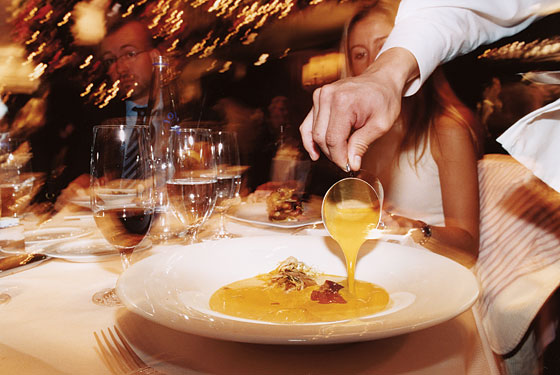
“Oh, thank God,” declared my friend the Food Aristocrat when I gave her the news. The great tidal wave of giant Vegas-style dining establishments that has flooded the city’s dining scene the last few years appears to have crested and washed out to sea. Down in the meatpacking district, you can still feast in great ocean-liner-size spaces if you wish, or drop thousands of dollars on sushi delicacies jetted in from around the globe. But New York turns out more prize-winning barbecue-pit masters these days than grandiose superstar chefs. In this hypercasual, eco-minded era, the really hot restaurants don’t require jackets or ties, and many don’t take reservations. Japanese cooks have ditched the big-box model and are once again opening elegant little restaurants in elegant little rooms. Dainty finger foods are the rage in Italian food, and the swells at the posh new spots along Park Avenue and at the Ritz aren’t clamoring for soufflés. They’re ordering platters of organic Swiss chard to go with their farm-grown dinners and spiking their $15 cocktails with carrot juice.
We analyze these curious dining trends, plus many more, in this, our annual compendium of all that’s stylish, fabulous, and new in the fickle galaxy of New York restaurants. In the following pages, you’ll find our recommendations for an entire year’s worth of serious eating, broken down, as usual, into categories reflecting the most notable culinary happenings of the moment. We will tell you where to procure the most lethal absinthe cocktails in town, instruct you on where to find a good duck egg for brunch, and provide a list of the most lavishly expensive haute cuisine establishments in which to blow the remnants of your year-end bonus. Consider it a kind of road map to take with you on your culinary ramblings. Oh, and if you’re looking for the finest Chinese grub in Brooklyn, we’ve got that, too, along with our yearly summation of New York’s best new restaurants, the best up-and-coming chefs, and, last but not least, the best venues, in this age of rampant culinary correctness, for a sinfully delicious, hormone-saturated, nonorganic feast.
We’re All Locavores Now…

The great Greenmarket tsunami, which began on the downtown fringes of the restaurant world three decades ago, has now spread to the grand, upmarket joints in midtown, engulfing everything in its path. Park Avenue matrons don’t have to travel down to Blue Hill anymore for their fix of seasonally correct veggies. They’re gathering at Michael Stillman’s antic new restaurant, Park Avenue Winter, a place where the menu, the décor, even the name change according to the rhythm of the seasons. In summertime, the daisy-yellow walls were affixed with tortoise shells; now, they’re colored a silvery igloo white. This loopy exercise in seasonal dining sometimes tips toward the bizarre, but it’s held together, in the end, by the steady high quality of Craig Koketsu’s cooking. If it’s July, try the soft-shell-crab tempura, served with avocado and sticks of jícama; in wintertime, stick to the beef, particularly the milky grilled veal chop, which is caked in a luxurious blanket of garlic and bread crumbs and surrounded by drifts of sautéed chanterelles.
Similar earthy specialties are on display at BLT Market, in the Ritz-Carlton Hotel, where that canny franchiser Laurent Tourondel is busy indoctrinating hordes of business lunchers and eager out-of-town millionaires into the cult of the artisanal, the farm-raised, and the locally grown. You can purchase pickled dilly beans and pots of locally raised honey at the front desk, and instead of carefully wrought foie gras canapés before dinner, every table receives a bowl of pickled vegetables and a baguette of fresh garlic bread in a paper bag. Tourondel began his career as a seafood maestro, so the real specialties on the menu are dishes like halibut, which is painted with layers of basil and parsley pesto, and the delicious Chatham cod, which the chef sinks, along with wheels of fresh eggplant, in a faintly spicy, curried broth. After that, wash down your meal the way the rest of the barnyard snobs do, with a weirdly bracing basil-cucumber Mojito or a Tom Collins–style drink called the Jackrabbit, which is spritzed, not unpleasantly, with carrot juice.
Marco Canora learned all about the art of high-minded Greenmarket cooking at Craft, where he ran the kitchen for one of the original high priests of the movement, Tom Colicchio. And if you wish to taste the purest kind of Slow Food cooking, done in high Italian style, you’ll find it these days at his new midtown restaurant, Insieme. From the typeface used on the studied menu to the stripped-down, workmanlike white-oak tabletops, the boxy little theater-district establishment echoes Craft in all sorts of derivative, mildly annoying ways. But you won’t find a rich, multilayered lasagne like this anywhere in the vicinity of Times Square, nor the pink, pasture-fed “baby beef tartare,” which Canora folds with lemon and porcini mushrooms. Pheasant eggs make the occasional appearance on the “contemporary” side of the restaurant’s menu, but the real delicacies here are the traditional ones, like the great fried-veal specialty fritto misto alla Lucchese, and the medley of softly boiled meats called lesso misto, which the chef leavens with horseradish cream and spoonfuls of freshly made salsa verde.
The Italian Small-Plates Invasion
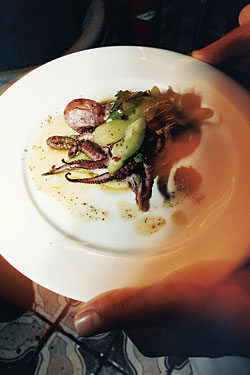
Forget about overstuffed gnudi, raw-fish crudi, and those giant, formally fashionable portions of rustically charred bistecca Fiorentina for two. Among cutting-edge Italian gastronomes, the rage right now are stuzzichini, or spuntini, or any kind of miniature, reasonably priced delicacy compact enough to fit on a tiny plate. I’m thinking of Keith McNally’s clamorous, slightly confused new Italian brasserie, Morandi, where the most accomplished dishes tend to be the little ones, like plates of golden, crisp fritto misto, and modest helpings of frizzled artichokes served with the stalks still intact, just like they do in Rome. Whenever I’m ambling down Eighth Avenue in the West Village, I like to duck into the raffish new bar-restaurant dell’anima for a stack of the crunchy house bruschette before proceeding to Centro Vinoteca, where my wife enjoys picking her way methodically through the seventeen “piccolini” items (she recommends the truffled eggs, the eggplant fritters, and the arancine rice balls) while I bolt down Anne Burrell’s crispy-edged gnocchi and bowls of the butter-soaked raviolo al’uovo, each of which contains a single gently poached egg.
Lunchtime is still the best time to dine at the great Bastianich outpost Lupa on strips of eighteen-month-old gran riserva prosciutto di Parma, followed by a dainty forkful or two of the classic oxtail coda alla vaccinara. But whenever I find myself trapped farther uptown, in that restaurant wasteland above Bloomingdale’s, I do what my stately Upper East Side mother does and drop in to Accademia di Vino on Third Avenue, where the tables are filled with famished shoppers gorging on bowls of freshly made spaghetti carbonara, slices of grilled lamb, and plum-size Parmesan fritters specked with nuggets of prosciutto. From there, the small-plate parade returns downtown to Bar Stuzzichini on Broadway, where you’ll find not one but two commodious bars filled with a motley collection of business lunchers, small-plates fanatics, and dazed-looking tourists on their way to Union Square. Begin your tidy little meal with that weirdly delicious Neapolitan specialty scamorza alla brace (toasted smoked mozzarella drizzled with chile-infused olive oil), proceed to the candy-size rolls of eggplant stuffed with creamy ricotta cheese, then reach a final, grand crescendo with a helping of chewy, pistachio-filled tagliolini al limone, perhaps, or the melting gnocchi all’amatriciana, composed of handmade gnocchi and smothered in a deeply flavored ragù of tomatoes, onions, and guanciale.
Sorry, No Reservations
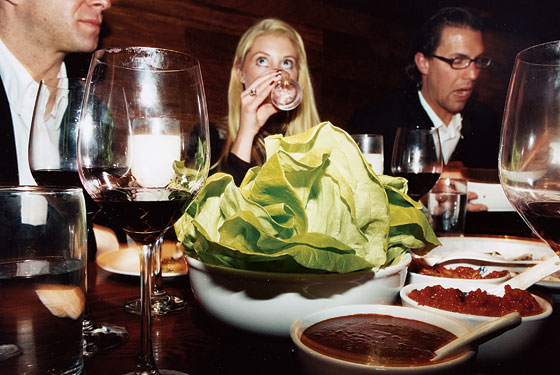
Once upon a time, the poshest sort of people agitated for reservations at fancy uptown restaurants manned by haughty maître d’s dressed in shiny black dinner coats. But in this, the no-jacket-required era, the hottest tables tend to be located in out-of-the-way neighborhoods in tiny-roomed establishments, many of which don’t take reservations at all. If you don’t believe me, go mingle on a frigid Saturday evening with the rest of the doomed hoi polloi outside Graydon Carter’s semi-private dining club, The Waverly Inn. To gain access to the pleasingly raffish dining-room sanctum occupied by Carter and his chums, you’ll need a special phone number or e-mail address, or you’ll have to show up personally, then get on your hands and knees and beg. Is it worth it? Maybe. The seafood items (classically prepared Dover sole, fresh “plank-grilled” trout with spindly organic carrots) are surprisingly good, and so is the fat, $13 Waverly burger, which was curiously enlivened, on the evening I enjoyed it, by a partially obscured view of what might or might not have been the back of Gwyneth Paltrow’s head.
They don’t take reservations at Gemma, either, so if you can’t get a table at the new, high-decibel Italian joint in the Bowery Hotel, elbow your way through the mob of banker boys and fashion assistants to the bar for helpings of the excellent fried zucchini flowers (when they’re in season), fresh sea-bass crudo splashed with grapefruit, and little wedges of crostini piled with chicken-liver purée. Farther uptown, in the Flatiron district, the crowd of burger hounds and assorted Belgian-beer aficionados begins massing on the sidewalk outside Resto before 6 p.m. The hamburger at this elegant Belgian gastropub is considered by some members of the city’s fractious burger community to be better than the fabled monster at that other great no-reservations gastropub, The Spotted Pig. I thought it was underwhelming by the grandiose burger standards of today, although the peppery, honey-soaked lamb ribs were worth the hour-long wait. Ditto the deviled eggs, served on little postage stamps of crisp-fried pork, and the great vat of beef-cheek carbonnade, which my garrulous waiter suggested I wash down with a tall glass of an amber Belgian ale called Kwak.
The most popular Italian restaurant on the Upper East Side continues to be Ron Suhanosky and Colleen Marnell-Suhanosky’s accomplished, perpetually crowded mom-and-pop shop, Sfoglia, and if you wish to keep current with the fashionable downtown dining scene, travel to 13th Street in the East Village and battle for a seat with the rest of the scruffy pork loons at David Chang’s Momofuku Ssäm Bar. Despite his James Beard award and fawning write-ups in countless glossy food magazines, Chang doesn’t take reservations, either. It’s possible to circumvent this policy by preordering the sumptuously massive, $180 bo ssäm, which, as every downtown meathead knows, is an entire Berkshire pork butt slow-cooked in gallons of sugar-drenched soy sauce and wine. Otherwise, you’ll have to wait patiently in line with the rest of the meat-obsessed sophisticates for a taste of the thin-sliced, delicately jellied veal-head terrine, followed by a bite or two of lamb’s belly. Or slip over to the newly relocated Momofuku Noodle Bar and queue up there for a taste of the chef’s special honeycomb tripe, which is slow-braised with bacon, chile peppers, and carrots and served in a white bowl, like Texas chili, but with a porcelain Chinese spoon.
International Brooklyn
To the borough’s honor roll of perpetually booked, yuppie-approved neighborhood dining destinations like Franny’s, Applewood, Dressler, and The Good Fork, let’s add the unlikely new Korean restaurant in Park Slope called Moim. The narrow room opens out to a pretty, even Zenlike, garden view in the back, and on winter evenings the little townhouse space feels warm and toasty, just like a good Korean barbecue should. But instead of animated Korean families, the tables are filled with members of the local gentry, sipping glasses of Rioja and madly twiddling on their iPhones between bites of thick fried pa jun pancakes and plump mandu dumplings messily stuffed with mushrooms. Not surprisingly, I liked the beefy dishes the best, like darkly caramelized oxtails soaked in sugar and soy sauce, stacks of soft, garlic-flavored pork ribs, and strips of the deliciously sizzling short ribs, which the local gastronomes supplement with that ubiquitous Korean specialty bibimbap, served in a hot stone bowl with a barely cooked egg on top.
In a region famous for its pizza meccas, the latest one is Lucali, on a leafy stretch of Henry Street in Carroll Gardens. The brick-walled room was suffused, on the evening I visited, with the sounds of opera arias and the smells of fresh pizzas baking. After you’ve devoured one of the hot, matzo-thin pies, top off your meal, like I did, with one of Mark Iacono’s signature hubcap-size calzones stocked with real Italian sausage from the old neighborhood. From there, our multiethnic culinary ramble proceeds to Silent H in Williamsburg, for a plate or two of shrimp toast, deep-fried on slices of French baguette, just like they do in the finer private kitchens of Hanoi. There’s an impressive selection of bánh mì sandwiches available at lunchtime, but this popular little restaurant’s real specialty is the thick grilled pork chop, which is bathed, like some elaborate Vietnamese version of steak au poivre, in peppercorns and a salty-sweet fish sauce.
The latest dining hot spot in restaurant-challenged Dumbo is Danny Mena’s evenings- only Front Street establishment, Hecho en Dumbo, where crowds of starving artists and local taco addicts converge each night for a taste of the thick corn sopes piled with chorizo, and the chef’s street-style mini corn tortillas, rolled with deposits of organic Berkshire pork or strips of steak squirted with cooling wedges of lime. But no international tour through the culinary wilds of Brooklyn would be complete without a visit to Lucky Eight, on the fast-growing Chinatown strip in Sunset Park. My friend the China Expert likes to retreat to this tidy, well-run establishment after his afternoon shopping, to feast on platters of crispy chicken scattered with crunchy bits of garlic, stacks of small Zhenjiang spare ribs subtly flavored with vinegar and coriander, and the bizarrely fresh “Hong Kong Bay style” lobster, which tastes like it’s just been hauled out of the chilly waters off Long Island and costs roughly $10 less than it would in the Chinatown of Manhattan or even Queens.
Barbecue Town, USA
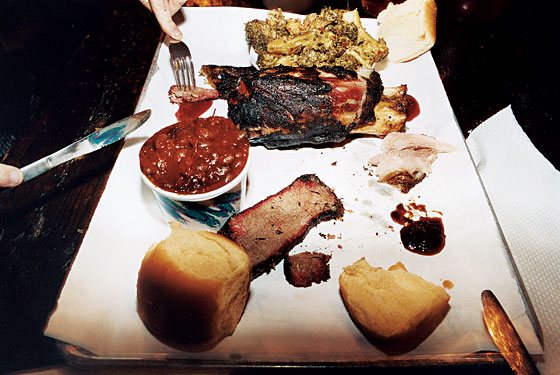
Not so long ago, New York City was considered a barbecue wasteland, on a par with other legendary barbecue wastelands like Paris, London, and L.A. But not anymore. Thanks to newfangled smoker technology and a new generation of inspired local pit masters, the city is in the midst of an unlikely meat-smoking renaissance. If you don’t believe me, take a seat with the rest of the yuppie brisket freaks at Hill Country, in the Flatiron district, where dinner is apportioned not by the sandwich or the slab but measured Texas style, by the pound, then flopped on great sheets of butcher paper. I like to get there in the early evening, before the crowds arrive, for my weekly ration of smoked “moist” brisket (the “lean” is good, but the fatty “moist” deckle cut is better), followed by several slabs of the densely flavorful beef shoulder, and a rack or two of the steamy pork ribs chopped from great smoky slabs by portly gentlemen in white butcher bibs. But if these calorie bombs send you clutching for your Lipitor, it’s possible to survive very nicely on the house chicken, which is brushed with a sweet barbecue sauce and falls gently from the bone when you tweak it with your fork.
The burned brisket ends and the slow-cooked pork shoulder are still my two favorite items on the bountiful, rigorously unhealthy menu at RUB, in Chelsea, and whenever I’m in need of a barbecue fix farther uptown, I like to speed up the West Side Highway to the frenzied and hectic Dinosaur Bar-B-Que complex on 131st Street, not for the ribs but for a bushel or two of the jumbo, pit-smoked, spice-rubbed, finger-licking chicken wings. For a true neighborly barbecue experience, however, I’ll pile the family in the car and find my way to Fette Sau, next to Tony & Sons Auto Repair on Metropolitan Avenue in the rambling, barely gentrified wilds of Williamsburg. They sell their slow-cooked beef and pork products market style here, too, and serve them to the rabble of festive local barbecue fiends at picnic tables set with rolls of paper towels and giant squirt bottles of home-brewed sauces. The thing to order on the ad hoc blackboard menu is the good old-fashioned pastrami, gnarled and peppery on its crunchy exterior and pink and slightly fatty within. I find this ancient regional delicacy goes best with tubs of sauerkraut and molasses-thick camp beans, which you can wash down with a fine selection of locally brewed artisanal beers, dispensed in giant gallon-size jugs or a decorous selection of mason jars.
Refined Japanese
Roughly a decade after it began, the era of the Godzilla-size, Japan-themed dining palaces seems mercifully to have ceased. Whenever I want to reminisce about that grandiose, bygone era, I drop in to Matsuri, in the basement of the Maritime Hotel, to gape at the Viking-size dining hall, before slipping into a seat at the always colorful, always frenetic sushi bar at Morimoto for a taste of Masaharu Morimoto’s intricate omakase creations. But in au courant Japanese-dining circles, the real action is at smaller, more nimble establishments like 15 East, off Union Square, where Masato Shimizu produces classic high-end sushi done in a minimalist, no-frills style. The talented young chef is a purist of the old school, curing his own ginger and marinating his sea eel in vats of sake. If you’re feeling flush, order the $75 tuna flight, which consists of five different cuts and grades of fatty albacore tuna, which the gregarious Shimizu likes to explain, for the young hedge-fund clientele who roost along the bar, with the help of a special laminated tuna chart.
Similar unexpected pleasures are available at Soto, which opened this spring among the smoke shops and tattoo parlors on lower Sixth Avenue. The polished little restaurant has no sign on the door, and night after night you will find its proprietor, Sotohiro Kosugi, in his spectacles and white sushi cap, bent behind the bar with his two loyal assistants, crafting a whole range of inventive small-plate delicacies. But among the city’s community of sushi snobs, this third-generation sushi chef is best known for his almost unnerving fondness for sea urchin, which he balances on little spools of yuba tofu, tosses with raw quail eggs and shreds of squid (“uni ika sugomori zukuri”), or whips into mousse form and shapes, with fresh lobster and a sprinkling of caviar, into an exotic savory layer cake.
The original Sushi of Gari, on 78th Street, is still the place I like to take my sushi-starved friends on the Upper East Side for a first-class fish feast. But when that poky space is filled up, we head to the new Manhattan outlet of the famous L.A. sushi temple Sasabune, on East 73rd Street, where everyone receives the same purist omakase dinner of hot butterfish dabbed with soy, say, or orange snapper dusted with yuzu and served, according to the specifications established at the West Coast original, on chaste white tea plates. For a more august Japanese meal, the place is Rosanjin, in Tribeca, where the gregarious proprietor, Jungjin Park, has made it his mission to educate the local big-money hipsters in kaiseki, the rarefied cuisine of the Kyoto emperors. At his discreet, nine-table establishment, $150 buys a nine-course banquet, including soft pieces of scallop flecked with gold leaf, little twigs of uni delicately sizzled in tempura batter, and wafer-size segments of rich, fatty tuna belly served in bowls of handmade porcelain, with chopsticks carved from cedarwood, as Park will tell you, by the finest chopstick-makers in Kyoto.
Second Acts
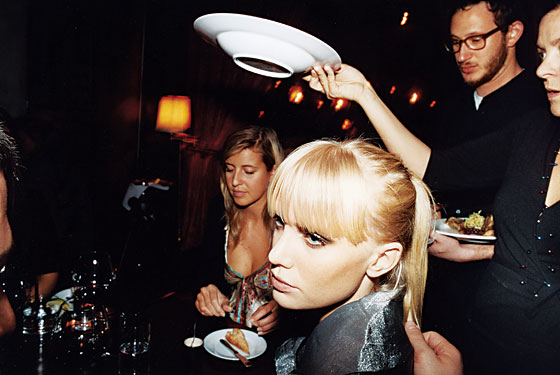
What do the city’s gifted young cooks do when they grow weary of being screamed at all day by their excitable superstar bosses? They take jobs running small kitchens in far-flung, soon-to-be-gentrified neighborhoods, where they can do some screaming of their own. Take Neil Ferguson, who, after years of abuse at the hands of that famous culinary lunatic Gordon Ramsay, has found peace, tranquillity, and a measure of respect at Allen & Delancey, on the Lower East Side. The raffish, deceptively stylish restaurant has a candlelit bar area up front, where you can buy all sorts of advanced mixological creations. But the real reason for trekking down to Allen Street is Ferguson’s cooking, which includes delicate iterations of stodgy European classics like bone marrow dressed with caviar and a purée of shallots, crunchy-skinned slices of Moulard duck, and a combination of lamb (braised neck and parsley-covered chop, over a buttery potato purée) that’s as good as any lamb dish at Ramsay’s star-crossed venture uptown.
During the twelve long years he spent as a kitchen slave in the Jean-Georges empire, Josh Eden earned the prison-yard nickname “Shorty.” Now he’s finally on the outside, working a hot little no-reservations joint of his own called Shorty’s.32. Arrive early to secure a table in the crowded, speakeasy-style space, and be sure to order Shorty’s gourmet riffs on classic comfort-food dishes, like golden roasted country chicken served with fried garlic and mashed potatoes, baked skate smothered in tomatoes and bacon, and the braised short ribs, which Shorty pairs with giant prison-yard-style helpings of his sinfully rich macaroni and cheese. You’ll also find good short ribs on the menu at Irving Mill, just off Union Square, where the kitchen is run by John Schaefer, who toiled for many years at Gramercy Tavern. The rabbit ragout is the great delicacy at this Danny Meyer–inspired establishment, although if it’s lunchtime, order the excellent house hamburger, which Schaefer sets on a dainty English muffin and adorns, in classic Haute Barnyard style, with a hint of sherried onions.
Harold Dieterle endured tours in various pressure-cooker kitchens around town, then survived the withering critiques of Tom Colicchio and his super-chef sidekicks to win the ludicrously popular, maddeningly addictive reality-TV show Top Chef. After all this chaos, it’s not surprising that his own West Village restaurant, Perilla, is a peaceful, neighborly space, with a scuffed bar up front and a row of comfortable, dimly lit banquettes stretching into the back of the room. Like all accomplished chefs of his generation, Dieterle serves up a respectable rendition of seared Berkshire-pork belly, as well as platoons of spicy duck meatballs served with a single quail egg decorously broken over the top. But if you’re wise, you’ll order one of his inventive, upscale dishes, like steamed red snapper with chanterelles, and the skillet-braised cuttlefish, which Dieterle sinks in a seafood reduction buttery and smooth enough to induce in even the most volatile kitchen screamer a stunned, admiring silence.
The New-Chef Parade
In the fraught, high-stakes world of big-time restaurants, tempers are short, strife is common, and armies of bedraggled chefs are always on the move. Lately, the chefs’ carousel has been spinning at warp speed, and several of the city’s grand establishments have benefited from an infusion of new talent in the kitchen. After perfecting his Haute Barnyard techniques with Dan Barber at Blue Hill at Stone Barns, the great Slow Food impresario Michael Anthony arrived a year or so ago to restore Danny Meyer’s Gramercy Tavern to its former greatness. Anthony is a master in the gentle art of poaching and braising, and he’s imbued the formerly tired, predictable menu with servings of smoked lobster, pork belly with baby turnips, and tight little ballotines of braised lamb shoulder soft enough to eat with a spoon. My friend the Barbecue Loon recommends the pulled-pork sandwich (dressed with apples and Savoy cabbage) on the revamped Tavern menu up front, and if you have a taste for country desserts, you won’t find anything better than the chocolate bread pudding, served with candied cherries and a scoop of vanilla ice cream spiked with anise.
Midtown’s newest kingpin of haute Italian cuisine is Michael White, who has succeeded the talented Scott Conant as the executive chef at L’Impero and Alto. At the Tudor City branch of L’Impero, White serves up elevated trencherman specialties like twirling housemade fusilli poured with a creamy, cheese-laced pork-shoulder ragù, and the grandiose controfiletto di manzo, a grilled sirloin heaped over fried potatoes and roasted mushrooms. But the prolific Rabelaisian cook reserves his most inspired new creations for Alto, on 53rd Street, where members of the starchy expense-account set are arriving in droves to gorge themselves silly on opulent pasta dishes like cream-soaked agnolotti stuffed with ground Piedmontese beef, fresh-made quills of garganelli covered with Piave cheese and little sticks of smoked Tyrolean prosciutto, and the superior house risotto, which, the last time I checked in, was laced with Parmesan, acorn squash, and spoonfuls of duck fat.
Oceana’s new chef, Ben Pollinger, recently won that posh midtown seafood palace its third-consecutive Michelin star, and at Fiamma, in Soho, the flamboyant out-of-towner Fabio Trabocchi has stocked the fancy new menu with ornate creations like Kobe-beef carpaccio and an inventive, aristocratic interpretation of that tricky peasant dish baby goat. But perhaps the most impressive kitchen overhaul of all has taken place at Le Cirque, where Sirio Maccioni’s latest chef, Christophe Bellanca, has expanded the pricey, formerly stolid menu to include a whole variety of sophisticated, radically pricey new treats. The grandly impersonal room underneath the Bloomberg tower remains filled with the usual collection of grimly smiling contessas and aging plutocrats tottering to and fro in their pin-striped suits. But when I dropped in not very long ago, there were an impressive nine specials of the day on the menu, along with all sorts of newfangled entrées: dim-sum-size ravioli swollen with foie gras, carefully deboned portions of squab crusted with crushed walnuts, and ribbons of chestnut-flavored pappardelle decked with braised pheasant, which the plutocrats merrily supplemented one night (for a $185 fee) with shavings of white truffle shipped direct, via Maccioni’s fabled connection, from the hills of Alba.
Barnyard Brunch
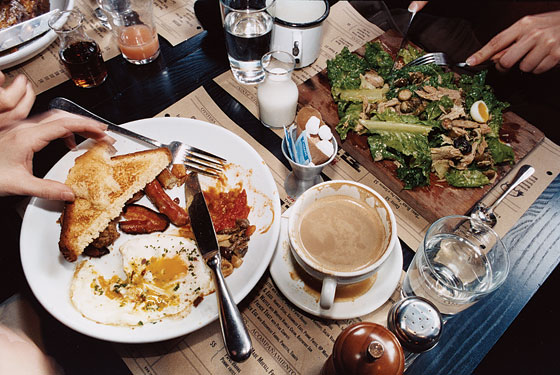
The imposing, profoundly nourishing country ham biscuit (stuffed with salty Kentucky ham, Grafton Cheddar, and homemade jam) served to the bohemian breakfast hordes at Egg is still my favorite mid-morning snack in Williamsburg, or anywhere else, for that matter. My daughters can’t decide which of the tasty brunch items they would like me to recommend at the popular new restaurant in the East Village called The Smith, although without a doubt the dish with the best name is an impressive assemblage of smoked ham, scrambled eggs, Gruyère, and home fries called the “Croaker.” When I wish to impress my righteous locavore friends, however, I take them down to The Tasting Room on Elizabeth Street for a groaning country feast of duck and free-range-pheasant eggs artfully arranged over piles of kasha, buttermilk-dipped fried chicken legs served with cool potato salad just like at a church picnic, and the properly fatty, even gnarly slabs of Red Wattle pork shoulder, smothered in fried eggs.
From there the barnyard bandwagon proceeds to Telepan, on 69th Street, where we’ll line up with the rest of the stolid Upper West Side burghers waiting to gobble down brunch-time helpings of Bill Telepan’s signature Pennsylvania-style scrapple, which the chef plates with a sweet, porky, country-style sauce between a bed of stewed collard greens and two wobbly coddled eggs. If you’re looking for a good duck egg on the Lower East Side, you’ll find it on the brunch menu at The E.U., on East Fourth Street. And if you want a really good stack of pancakes in the West Village, you’ll find them at The Little Owl, on Bedford Street, where Joey Campanaro serves up his patented meatball sliders soaked in breakfast gravy, and, if you still have the energy and the will, one of the great gourmet cheeseburgers in town, made with melted Cheddar, curls of applewood-smoked bacon, and a freshly toasted brioche bun.
If you find yourself staggering woozily around the fringes of the meatpacking district on some lost weekend morning, may I recommend the gourmet version of that great hangover buster, bacon and eggs: a wok-fried farm egg and Malaysian-spiced pork belly over Pullman bread, offered on the new brunch menu at Zak Pelaccio’s Fatty Crab. My wife finds that the compact breakfast club sandwich (two fried eggs, smoked bacon, avocado, spicy mayonnaise) available around the corner, at Cafe Cluny, achieves a similar purpose, albeit in a slightly more civilized, ladylike way. When we want to show my starchy midwestern in-laws a more sedate family-brunch experience, we head to Provence, on Macdougal Street, where brunch experts Vicki Freeman and Marc Meyer have given the venerable restaurant a much-needed face-lift. The atmosphere is slightly more dignified than at their other great brunch mecca, Cookshop, and if you’re smart, you’ll ask to be cordoned off with your unruly children in the sun-splashed, semi-childproof garden room, where you can dine in relative peace on toasty baguettes spread with crème fraîche and honey, thick croque-madames topped with sunnyside eggs, and the little dumpling-shaped house beignets stuffed with currants, sugared apples, and ricotta cheese.
Lunchtime Gourmet
With fine-dining restaurant prices going through the roof, lunch is my favorite time to sample elevated gourmet snacks, like the golden-fried $20 fritto misto Amalfitano, available at the Bastianich empire’s perpetually outstanding theater-district outpost, Esca. That’s only a couple of dollars less than the legendary $28 prix fixe luncheon at Jean Georges, which was enlivened on one of my recent visits by lumps of fresh uni served with jalapeño on little squares of brown, buttered toast. But you’ll get the most profound bang for your lunchtime buck at Anthos on 52nd Street, where I like to go with my skinny fashion-editor friends to watch them stare in wonder at Michael Psilakis’s epic lamb burger. There are fat hilopita egg noodles available, too, and smoked octopus flavored with lemon confit, but nothing packs the wallop of the $20 fusion burger, which the chef mixes with secret deposits of pork and crushed garlic, grills in caul fat, and stacks on a toasted brioche bun.
If you can’t find a seat amid the jabbering hordes of editors, tourists, and art professionals who gather daily in the grill room of The Modern, then sneak behind the museum to Gray Kunz’s new venture, Grayz, which occupies the old Aquavit space in Nelson Rockefeller’s former townhouse on 54th Street. The little café tables are scattered here and there in the warrenlike rooms, so belly up to the cozy little bar for a cool gimlet poured straight up with cucumber juice, and a couple of opulent Grayz oysters Rockefeller, which are presented at supper time on a row of silver spoons. If you’re in the mood for a slightly more hearty feed, order Kunz’s famous braised short ribs, which come wreathed, in the evenings, with creamed spinach and a crown of retro horseradish foam, or sandwiched, at lunchtime, between pieces of toasty ciabatta in the regally named “short-rib croque-monsieur.”
When I’m in the mood for a more casual, down-home midday snack, I’ll pay $9.50 for a bowl of the classic, organically pure “shiso” ramen at the new East Village noodle mecca Ramen Setagaya. My two favorite afternoon sandwiches are the little skirt steak “bocata” dressed with tangy cured tomatoes and deposits of melted Mahón cheese at Seamus Mullen’s Boqueria, and the deliciously messy hot-pressed Sikorski kielbasa Reuben at Borough Food & Drink, constructed, in case you didn’t know, with great greasy kielbasa links trucked in from Greenpoint. For a more leisurely, highbrow afternoon feast, the choice is Daniel Humm’s aptly named “Gourmand Tasting Lunch” at the newly revived Eleven Madison Park, followed by a stealthy visit around the corner to Andrew Carmellini’s inspired, constantly improving Flatiron-district establishment A Voce. My last wintry late-afternoon lunch there included crostini spread with whipped chicken liver and foie gras, a bowl of gently stewed Tuscan tripe with a fried duck egg, and for dessert, a frosty silver bowl of vanilla ice cream dripped with truffle oil, with a crumbling of biscotti on top.
Mixology Madness
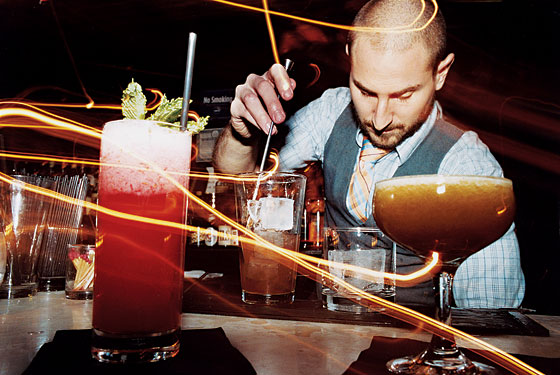
That noted mixologist Jim Meehan, who plumbed the glories of the Victorian-era gin cocktail at Pegu Club, in Soho, has moved on to an even more obscure, reservations-only speakeasy joint in the East Village called PDT. The name stands for “Please Don’t Tell,” and to obtain a seat among the rows of quietly murmuring hipsters at the Stygian, candlelit bar, you must call for a same-day reservation after 3 p.m. I recommend the mind-bending, off-the-menu absinthe cocktail called the “Corpse Reviver No. 2” (absinthe, Lillet, Cointreau, lemon), and, to go with it, a generous helping of fluffy gold tater tots from Crif Dogs next door. If I can still walk after that, I’ll stagger a couple of blocks south, to the raffish new cocktail hangout Death & Co., to dine on sophisticated bar snacks like lamb sliders, and quesadillas stuffed with braised duck, before delving into the legendary house punches, which have properly lethal names like “Spread Eagle” and “Jersey Lightning” and are mixed the old-fashioned way, by burly, bearded mixologists, in big communal bowls.
“Crumble” is the name of my wife’s favorite libation at Tailor, on the lower fringes of Soho, and the best place to sip this uncannily smooth potion made with buttered rum and cloves is not in the dim, sparsely populated dining room upstairs but down at the bar, with a perfectly matched portion of sweet, fatty pork belly garnished with miso-flavored butterscotch. The caboose-size bar is also the favorite gathering spot at Danny Abrams’s posh new bistro venture on Macdougal Street called Smith’s. The stylish little space features nine bar seats, plush green-velvet walls, and a worn Afghan rug on the floor. On weekends the crowded little room is packed with elegant booze hounds, so go on a weeknight, when things are quieter. Call for your classic martini straight up, then commence working your way through the accomplished roster of bar snacks like lobster deviled eggs, pickled shiitake mushrooms, and bowls of foam-covered country eggs served, in accordance with current fashion, over a mess of Anson Mills grits.
Junior Merino is the resident cocktail genius at Rayuela, down on Allen Street, and his most inspired creation is called “Coming Up Roses” (Bacardi, Champagne, lime, rose water, plus rose petals), which I like to sip in the lounge under the shade of the restaurant’s real live olive tree. In a town overrun with wine bars of every imaginable stripe, the fashionable new choice is Solex, on lower First Avenue, where the menu includes a blizzard of French-style puff pastries, and the ceiling of the beautifully appointed room looks like the interior of a long, glowing seashell. For the ultimate in a rowdy, stick-to-your-ribs feast, however, I like to join the mob of Australian expats and fashionista assistants at the boisterous double-sided bar at Kingswood. This perpetually hopping establishment in the Village feels, at first, like any other downtown gin joint. But the riotous atmosphere is offset by the surprisingly accomplished menu, which includes improbably delicious bowls of Goan fish curry, giant lamb chops crusted with herbs, and the imposing “Ruby’s Bronte Burger,” which is dressed with a carefully arranged fan of avocado and served with a twirl of frites scented with truffle oil.
Steaks and Chops
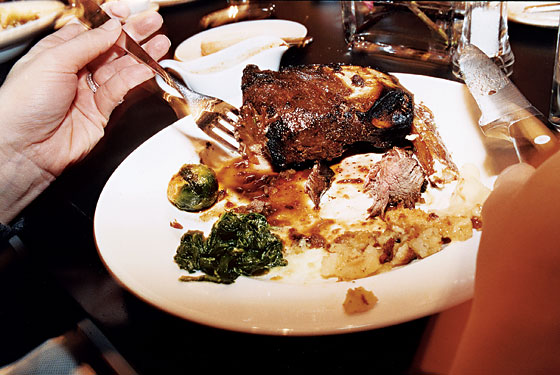
In this fastidious, eco-mad era, my fatso, beef-obsessed friends tend to be focused less on the restaurants in which their favorite sirloin is served than on the idyllic boutique farms on which the best beef cattle are raised. Hence my colleague the Steak Loon’s fondness for the elaborate new steak palace on lower Park Avenue, Primehouse New York. Stephen Hanson’s latest restaurant boasts a bar the size of a small barn, a “Himalayan-rock-salt room” for aging his pricey slabs of beef, and even its own prodigious bull, named Prime, who works tirelessly down at the Creek Stone Farms in Kentucky to sire prime Black Angus beef cattle on the restaurant’s behalf. If you don’t have $49 to spend on the delicious Kansas City bone-in sirloin, the Steak Loon recommends the $24 hanger steak, which is topped with fresh chimichurri sauce. Then supplement it with a sizzling platter or two of “old school” hash browns dripped in bacon fat, a tower of Frisbee-size onion rings, and, for dessert, the imposing bananas-Foster sundae, made with bananas, caramel, tankards of vanilla ice cream, and a shot of rum, all mingled in a big glass fishbowl, with a giant pecan tuile on top.
The best boutique cut of beef in midtown remains the $46 chile-rubbed Brandt Farms prime rib eye available at Michael Lomonaco’s Porter House New York on the fourth floor of the Time Warner Center food mall. And the city’s dwindling band of Kobe-beef addicts are presently haunting the cavernous room at Craftsteak in the meatpacking district, where a cool $102 will get you a fix of the legendary twelve-ounce Wagyu strip, shipped direct from the Strube Ranch in Texas. When I grow weary of all this exaggerated steakhouse grandeur, I like to drop in to Perry Street for a taste of the grilled tenderloin (dripped, in a most unhealthful way, with liquid Gruyère cheese), before proceeding to that other noted non-beef joint, Kefi, where a mere $19.95 buys a platter of superb lamb chops, which the wunderkind chef Michael Psilakis serves just like in the old country, with spinach-laced country rice, plenty of frizzled garlic, and a scattering of fresh parsley.
The grilled, bone-in Black Angus strip at Ouest gets my other vote for top steak and chop dish on the Upper West Side, but downtown, in my own neighborhood, the blue ribbon goes to Joey Campanaro’s new spinoff on Carmine Street called Market Table. This frenzied joint has all sorts of accomplished non-steak items on the menu, like short ribs sunk in gnocchi, and an already semi-legendary lunchtime cheeseburger, served with a tangle of fries tossed with Old Bay spice. But when I finally managed to secure a table in the crowded little room not long ago, the dish everyone fought over was the New York strip, courtesy of New York’s great beef wholesaler Pat LaFrieda. You can get the marbled LaFrieda sirloin expertly grilled, over a mess of arugula salad and crispy fried artichokes, at the restaurant itself. Or purchase the same beef cut to order at the restaurant’s market counter up front, then take it home and grill it yourself.
The Big Splurge
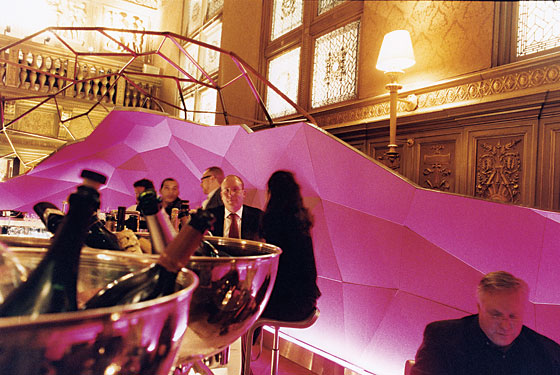
Effete gastronomes may have raised farmer’s grub to the level of haute cuisine, but restaurant prices have never been higher in New York, and there are still all sorts of extravagant old-world establishments in which to fritter away your hard-earned cash. My current favorite venue for a discreet midtown feed is Gilt in the Villard Mansions, where early last year Daniel alumnus Christopher Lee replaced the temperamental Englishman Paul Liebrandt in the kitchen. Lee has a special fondness for white truffles (his restaurant paid $8,000 for one last fall), but his most inspired creations tend to be subtle reworkings of opulent old-school favorites. The ultrafresh yellowfin-tuna tartare comes with a little stack of crispy, piping-hot scallion pancakes on the side, and if you order the chef’s New Age version of beef Wellington to go with your $10,500 bottle of ’85 Romanée-Conti Grand Cru, you’ll find that it’s stuffed not with beef but with yellowfin tuna and is cut in little wheels like a decorative sushi roll from Japan.
Daniel Boulud’s long-awaited Upper West Side wine bar, Bar Boulud, finally opened this week, and Alain Ducasse’s endlessly delayed, tortuously named Adour Alain Ducasse at the St. Regis New York is soon to follow. But until those august wine-centric establishments find their footing, Cru, on lower Fifth Avenue, is still the place to drop $15,000 on a good magnum of Château Lafite. According to my deep-pocketed culinary spies, the latest seasonal taste thrill on Masa Takayama’s $400 omakase menu at Masa is the drained and deep-fried sperm sac of the deadly Japanese fugu fish. Across the hall, a whole variety of less perilous delicacies is available, for a mere $250, on Thomas Keller’s ever-evolving nine-course tasting menu at Per Se, and if you wish to spend a sizable amount of capital on the latest in haute Italian dining, I recommend you join the rest of the fat-cat wiseguys gorging on the little Kobe-beef “tagliata” featured on the $150 “Grand Tasting Menu” at that cavernous meatpacking-district institution Del Posto.
The price of the prix fixe luncheon at Le Bernardin has been bumped up to a hefty $64, which is still a relative bargain compared with the $55 they’re charging the swells at the Grill Room of The Four Seasons for a modest lunchtime helping of fillet of bison adorned with foie gras and truffle sauce. Dollar for dollar, the bar menu at Terrance Brennan’s Upper West Side establishment, Picholine, remains my favorite way to experience the sophisticated pleasures of the new Spanish cuisine. The elite “chef’s table” at Gordon Ramsay at the London is where many of my morose banker friends seem to be going lately to toast the good old days, but if you wish to show your millionaire friends what real cutting-edge Continental cuisine looks like, then take them to the bar at L’Atelier de Joël Robuchon, in the Four Seasons Hotel. The room still feels out-of-step with the food, but Robuchon’s pointy little baguettes are the best in the city, and if you want proof that fancy French cooking isn’t quite dead yet, order the eight-course, $190 “menu découverte,” which begins with spoonfuls of silky fresh sea urchin seized in lobster gelée and concludes, in a most dignified manner, with a simple cup of espresso and a selection of festively colored macaroons.
And Desserts
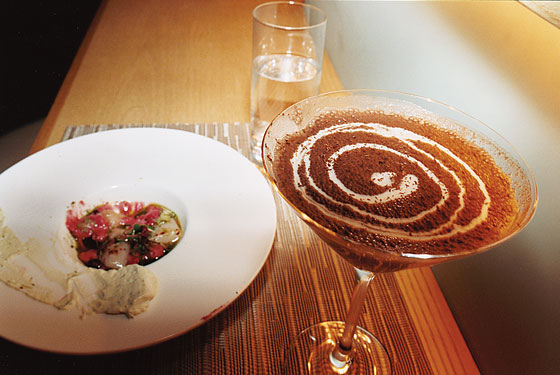
In the popular, ever-expanding category of preciously overwrought dessert-bar confections, this year’s gold medal goes to the kaffir-lime meringue available at Pichet Ong’s tiny twenty-seat establishment P*Ong, on West 10th Street. This festive creation contains all sorts of unlikely, esoteric ingredients, like basil seeds and shaved rhubarb ice, but the key element is the lightly crunchy meringue itself, which is finished with a decorative twirl, like some culinary version of Imelda Marcos’s summer hat. My haughty Chinese-food-scholar friends were unanimous in their condemnation of the tepid savory items at Ian Schrager’s disappointing Asian dining palace, Wakiya, in the Gramercy Park Hotel. But these grizzled veterans had only complimentary things to say about the ingenious fusion desserts, in particular the lemony génoise cake adorned with milky chunks of almond tofu, and the Pan-Asian affogato, which consists of high-octane espresso dripped, in the Vietnamese style, into a cup of crushed cocoa and condensed-milk ice cream.
My dessert-addled daughters consider the plain frozen yogurt (with raspberries and Fruity Pebbles) at the new Red Mango store on Bleecker Street to be slightly superior to the exact same dish available across the street at Pinkberry, even though their father points out that Pinkberry is a little cheaper, and that the red-and-white Red Mango store looks unsettlingly like a seedy airport outlet for Avis. Paradis to Go is where the girls like to go for their after-school fix of the giant, chip-rich chocolate-chip cookies, and for a more classic pastry treat their choice is Caffe Falai, on Lafayette Street, where we sit under the glittering little chandeliers over the bar and eat little spoonfuls of Iacopo Falai’s sweet tiramisu and the gleaming, deeply satisfying flourless chocolate cake, which is almost chewy in its richness and touched on top with a little dot of gold leaf.
If you’re looking for similar decadent pleasures in midtown, book a table at Alto, put on your best coat and tie, and when the waiter arrives, begin madly scribbling notes on a random piece of paper. With luck, you’ll be mistaken for a disreputable, overweight restaurant critic, and the chef will send out his famous off-the-menu ice-cream confection, composed of toasted almonds and three scoops of vanilla, piled with shavings of black truffle, and drizzled with warm, salty butterscotch sauce. But there’s no more fitting way to end a restaurant binge in this green, no-frills gourmet era than with a furtive late-night visit to The Dessert Truck, on University Place and 8th Street. The dangerously addictive chocolate bread pudding ($5) is prepared by a former pastry chef at Le Cirque, and comes drowned in a luxurious crème anglaise. But my favorite nightcap is the simple $3 cup of Valrhona hot chocolate. Have a few sips of this rich potion out on the sidewalk with the rest of the itinerant foodies, then take it home, put it in the refrigerator, and recycle it for your eco-conscious children the next day as gourmet chocolate pudding.
